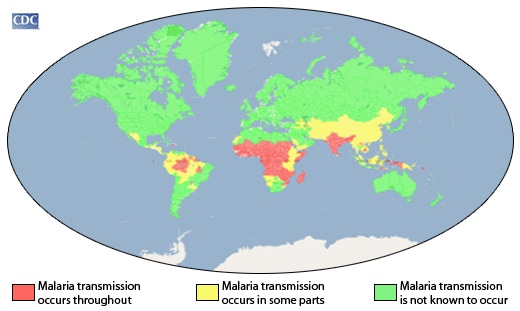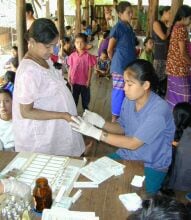Malaria’s Impact Worldwide
In 2020, an estimated 627,000 people died of malaria—most were young children in sub-Saharan Africa. Within the last decade, increasing numbers of partners and resources have rapidly increased malaria control efforts. This scale-up of interventions has saved millions of lives globally and cut malaria mortality by 36% from 2010 to 2020, leading to hopes and plans for elimination and ultimately eradication. CDC brings its technical expertise to support these efforts with its collaborative work in many malaria-endemic countries and regions.
Click here to learn more about how to reduce Malaria’s Impact
Malaria occurs mostly in poor tropical and subtropical areas of the world. In many of the countries affected by malaria, it is a leading cause of illness and death. In areas with high transmission, the most vulnerable groups are young children, who have not developed immunity to malaria yet, and pregnant women, whose immunity has been decreased by pregnancy. The costs of malaria – to individuals, families, communities, nations – are enormous.

Malaria occurs mostly in poor, tropical and subtropical areas of the world. Africa is the most affected due to a combination of factors:
- A very efficient mosquito (Anopheles gambiae complex) is responsible for high transmission.
- The predominant parasite species is Plasmodium falciparum , which is the species that is most likely to cause severe malaria and death.
- Local weather conditions often allow transmission to occur year round.
- Scarce resources and socio-economic instability have hindered efficient malaria control activities.
- In other areas of the world, malaria is a less prominent cause of deaths, but can cause substantial disease and incapacitation, especially in some countries in South America and South Asia.
Malaria is one of the most severe public health problems worldwide. It is a leading cause of death and disease in many developing countries, where young children and pregnant women are the groups most affected. According to the 2021 World Malaria Report:
- Nearly half the world’s population lives in areas at risk of malaria transmission in 87 countries and territories.
- In 2020, malaria caused an estimated 241 million clinical episodes, and 627,000 deaths. An estimated 95% of deaths in 2020 were in the WHO African Region.
 External Link Icon
External Link IconPregnant woman having a blood smear taken at an antenatal clinic at the Maela Camp in Thailand near the Burmese Border. Pregnant women are at increased risk of malaria. Image contributed by the Shoklo Malaria Research Unit, Mae Sot, Thailand.
The most vulnerable are persons with no or little immunity against the disease. In areas with high transmission (such as Africa south of the Sahara), the most vulnerable groups are:
- Young children, who have not yet developed partial immunity to malaria
- Pregnant women, whose immunity is decreased by pregnancy, especially during the first and second pregnancies
- Travelers or migrants coming from areas with little or no malaria transmission, who lack immunity
In areas with lower transmission (such as Latin America and Asia), residents are less frequently infected. Many persons may reach adult age without having built protective immunity and are thus susceptible to the disease, including severe and fatal illness.
Malaria imposes substantial costs to both individuals and governments.
Costs to individuals and their families include purchase of drugs for treating malaria at home; expenses for travel to, and treatment at, dispensaries and clinics; lost days of work; absence from school; expenses for preventive measures; and expenses for burial in case of deaths.
Costs to governments include maintenance, supply and staffing of health facilities; purchase of drugs and supplies; public health interventions against malaria, such as insecticide spraying or distribution of insecticide-treated bed nets; lost days of work with resulting loss of income; and lost opportunities for joint economic ventures and tourism.
Direct costs (for example, illness, treatment, premature death) have been estimated to be at least US $12 billion per year. The cost in lost economic growth is many times more than that.